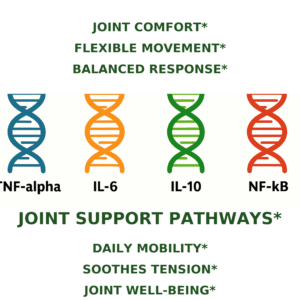ArthritiCare by Nature
Arthritis support works best when you support your body, not fight it.
ArthriCare by Nature combines Moringa, Boswellia, and Green Tea into one clean, plant-based formula designed to support not just joint comfort, but whole-body wellness. This daily blend helps maintain a balanced inflammatory response, promote natural vitality, and nourish your health from head to toe — and a whole lot more. [6][12]
Research has identified more than one hundred distinct types of arthritis and joint-related conditions, each involving complex interactions between inflammation, tissue stress, and mobility—meaning no single approach fits everyone. [1][2] ArthritiCare by Nature is designed to support the body’s natural ability to maintain joint comfort and flexibility. [2][10] Many individuals notice a natural sense of relief, ease of movement, and improved joint comfort as part of their ongoing wellness routine—supporting the body’s natural cushioning and lubrication between joints for a smoother, more comfortable range of motion. [2][7][8] ArthritiCare is a trusted, long-term ally for joint health and flexibility. [10][11]
ArthritiCare by Nature is available at Amazon
 Research in the fields of arthritis and joint-health sciences has identified TNF-alpha, IL-6, IL-10, and NF-κB as key genetic signaling regulators that help maintain the body’s normal immune and inflammatory balance. [3][4] Each of these molecular pathways helps coordinate how joint tissues naturally respond to everyday wear, physical stress, and the aging process—contributing to overall joint comfort and flexibility. [3][5] These same pathways have also been the focus of extensive scientific and pharmaceutical research exploring their importance in immune and joint health. [3][4][5] The multi-pronged, plant-based nutrients in ArthritiCare by Nature naturally support these pathways, helping the body maintain joint integrity, flexibility, and comfort in well-researched, natural ways. [5][6] This clean, research-inspired formula works in harmony with your body, offering gentle, effective support without harsh synthetic additives or unnecessary chemicals your body doesn’t need. [6][12]
Research in the fields of arthritis and joint-health sciences has identified TNF-alpha, IL-6, IL-10, and NF-κB as key genetic signaling regulators that help maintain the body’s normal immune and inflammatory balance. [3][4] Each of these molecular pathways helps coordinate how joint tissues naturally respond to everyday wear, physical stress, and the aging process—contributing to overall joint comfort and flexibility. [3][5] These same pathways have also been the focus of extensive scientific and pharmaceutical research exploring their importance in immune and joint health. [3][4][5] The multi-pronged, plant-based nutrients in ArthritiCare by Nature naturally support these pathways, helping the body maintain joint integrity, flexibility, and comfort in well-researched, natural ways. [5][6] This clean, research-inspired formula works in harmony with your body, offering gentle, effective support without harsh synthetic additives or unnecessary chemicals your body doesn’t need. [6][12]
 ArthritiCare by Nature supports optimal joint function by helping the body maintain healthy lubrication and natural cushioning within the joints for fluid, comfortable movement. [7][8] This advanced, plant-based blend nourishes cartilage and supports the body’s natural production of joint fluids that help keep motion effortless and balanced. [7][8] Research in scientific journals has shown that hyaluronic acid—a key component of joint fluid—plays an important role in supporting smooth mobility and comfortable joint movement. [7][8] By promoting proper hydration within connective tissues, ArthritiCare helps sustain smoother motion, greater flexibility, and long-lasting joint comfort. [7][8] Working in harmony with your body, this clean, plant-based formula delivers lasting nourishment for your joints—pure, powerful, and naturally effective. [6]
ArthritiCare by Nature supports optimal joint function by helping the body maintain healthy lubrication and natural cushioning within the joints for fluid, comfortable movement. [7][8] This advanced, plant-based blend nourishes cartilage and supports the body’s natural production of joint fluids that help keep motion effortless and balanced. [7][8] Research in scientific journals has shown that hyaluronic acid—a key component of joint fluid—plays an important role in supporting smooth mobility and comfortable joint movement. [7][8] By promoting proper hydration within connective tissues, ArthritiCare helps sustain smoother motion, greater flexibility, and long-lasting joint comfort. [7][8] Working in harmony with your body, this clean, plant-based formula delivers lasting nourishment for your joints—pure, powerful, and naturally effective. [6]
ArthritiCare by Nature is crafted to provide effective, natural joint support at a fraction of the cost of many synthetic or complicated alternatives. [10] Each serving delivers plant-based nutrients that work in harmony with your body to help maintain healthy joint lubrication, flexibility, and comfort—supporting smooth, fluid movement without costly treatments or unnecessary additives. [10][12] With ArthritiCare, you get clean, food-based, science-backed ingredients and meaningful support for lasting joint health at a low price, designed to be both affordable and accessible to all. [10][12]
Joint stiffness and discomfort can gradually increase over time, which is why taking steps to support long-term joint health early is so important. [2][9] For people living with arthritis, a food-based, non-synthetic approach can work with the body—not against it—and many people notice steadier support over time. [6][11][12]
At ArthritiCare by Nature, we’re deeply committed to your health, happiness, and confidence. Many customers notice meaningful improvements within the first few weeks or after their first bottle. [11] If you begin to feel noticeable improvements in your comfort, mobility, or joint fluidity, we encourage you to make ArthritiCare by Nature part of your daily routine.
Consistent use allows your body to continue benefiting from the natural nutrients that support lasting joint comfort, flexibility, and ease of movement. [10][11] We stand behind every bottle because we believe natural care should come with peace of mind. [12]
Explore in-depth information on every ingredient and the peer-reviewed studies highlighting its role in inflammation regulation, mobility improvement, and sustained joint wellness.
FOOTNOTES & REFERENCES
[1] World Health Organization. Musculoskeletal conditions.
https://www.who.int/news-room/fact-sheets/detail/musculoskeletal-conditions
[2] Hunter DJ, Bierma-Zeinstra S. Osteoarthritis. The Lancet. 2019;393(10182):1745–1759.
https://doi.org/10.1016/S0140-6736(19)30417-9
[3] Firestein GS, McInnes IB. Immunopathogenesis of rheumatoid arthritis. Immunity. 2017;46(2):183–196.
https://doi.org/10.1016/j.immuni.2017.02.006
[4] Smolen JS, Aletaha D, McInnes IB. Rheumatoid arthritis. Nature Reviews Disease Primers. 2018;4:18001.
https://doi.org/10.1038/nrdp.2018.1
[5] Gupta SC, Sundaram C, Reuter S, Aggarwal BB. Regulation of inflammatory pathways by natural dietary agents.
Biochimica et Biophysica Acta – Molecular Basis of Disease. 2014;1842(12):2456–2466.
https://doi.org/10.1016/j.bbadis.2014.02.014
[6] Calder PC. Dietary factors and low-grade inflammation. Nutrition Research Reviews. 2013;26(2):169–180.
https://doi.org/10.1017/S095442241300016X
[7] Cowman MK, Lee HG, Schwertfeger KL, McCarthy JB, Turley EA.
Hyaluronan: A multifunctional, megadalton, stealth molecule.
Arthritis Research & Therapy. 2015;17:92.
https://doi.org/10.1186/s13075-015-0607-6
[8] Altman RD, Moskowitz R.
Hyaluronic acid in the treatment of osteoarthritis of the knee: a review.
Osteoarthritis and Cartilage. 1998;6(2):85–92.
https://doi.org/10.1053/joca.1998.0091
[9] Litwic A, Edwards MH, Dennison EM, Cooper C.
Epidemiology and burden of osteoarthritis.
British Medical Bulletin. 2013;105:185–199.
https://doi.org/10.1093/bmb/lds038
[10] Bannuru RR, Osani MC, Vaysbrot EE, et al.
OARSI guidelines for the non-surgical management of knee, hip, and polyarticular osteoarthritis.
Osteoarthritis and Cartilage. 2019;27(11):1578–1589.
https://doi.org/10.1016/j.joca.2019.06.011
[11] Messier SP, Mihalko SL, Legault C, et al.
Effects of diet and exercise on osteoarthritis symptoms and function.
JAMA. 2013;310(12):1263–1273.
https://doi.org/10.1001/jama.2013.277669
[12] U.S. Food and Drug Administration.
Dietary Supplements: Structure/Function Claims.
https://www.fda.gov/food/dietary-supplements/structurefunction-claims

